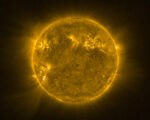The National Oceanic and Atmospheric Administration (NOAA) has revealed the first images from its advanced space-based tool, the Compact Coronagraph (CCOR-1), mounted on the GOES-19 satellite. This instrument marks a milestone in solar observation, offering unprecedented clarity in monitoring solar activity. The CCOR-1’s role is to observe the sun’s outer atmosphere, known as the corona, and to track solar phenomena such as coronal mass ejections (CMEs), which can impact space weather on Earth.
Launched in June 2024, CCOR-1 officially began its solar observation mission on September 19, aiming to enhance our understanding of solar storms. These powerful eruptions can release massive bursts of energy and charged particles into space, potentially disrupting satellite communications, power grids, and GPS systems. Positioned on the GOES-19 satellite, which orbits Earth in a geostationary orbit, CCOR-1 provides a constant, real-time stream of data that is crucial for improving space weather forecasting.
What sets CCOR-1 apart from previous solar observation tools is its ability to block the sun’s intense glare using an occulting disk. This allows the coronagraph to capture high-resolution images of solar eruptions, such as CMEs, without being overwhelmed by the sun’s brightness. One of the most striking images captured on September 29 shows a CME bursting from the sun’s eastern limb at 8:15 a.m. EDT. The high-speed plasma streams from the sun’s surface, with speeds reaching up to thousands of miles per second, offering scientists a closer look at the dynamics of solar storms.
These groundbreaking images not only provide a clearer understanding of solar activity but also represent a significant leap in space weather forecasting. With real-time monitoring and detailed observations, CCOR-1 will help NOAA predict the potential impact of solar storms on Earth’s magnetic field and technological infrastructure. This advancement is a vital step forward in protecting both space-based assets and ground-based systems from the disruptive effects of solar weather.


















